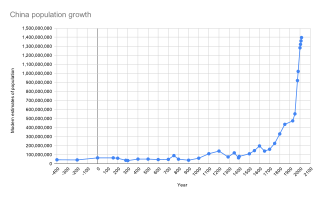 W
WDemographic history is the reconstructed record of human population in the past. Given the lack of population records prior to the 1950s, there are many gaps in our record of demographic history. Historical demographers must make do with estimates. models and extrapolations. For the methodology, see Historical demography
 W
WEarly human migrations are the earliest migrations and expansions of archaic and modern humans across continents. They are believed to have begun approximately 2 million years ago with the early expansions of hominins out of Africa of Homo erectus. This initial migration was followed by other archaic humans including H. heidelbergensis, which lived around 500,000 years ago and was the likely ancestor of both Denisovans and Neanderthals. Early hominids were said to have "crossed land bridges that were eventually covered in water".
 W
WMedieval demography is the study of human demography in Europe and the Mediterranean during the Middle Ages. It estimates and seeks to explain the number of people who were alive during the Medieval period, population trends, life expectancy, family structure, and related issues. Demography is considered a crucial element of historical change throughout the Middle Ages.
 W
WThe Population history of China covers the long-term pattern of population growth in China and its impact on the History of China. For recent trends see Demographics of China and China.
 W
WPrehistoric demography, paleodemography or archaeological demography is the study of human and hominid demography in prehistory.
 W
WThe total number of military and civilian casualties in World War I was about 40 million: estimates range from around 15 to 22 million deaths and about 23 million wounded military personnel, ranking it among the deadliest conflicts in human history.
 W
WWorld War II was the deadliest military conflict in history. An estimated total of 70–85 million people perished, or about 3% of the 1940 world population. Deaths directly caused by the war are estimated at 50–56 million, with an additional estimated 19–28 million deaths from war-related disease and famine. Civilian deaths totaled 50–55 million. Military deaths from all causes totaled 21–25 million, including deaths in captivity of about 5 million prisoners of war. More than half of the total number of casualties are accounted for by the dead of the Republic of China and of the Soviet Union. The tables below give a detailed country-by-country count of human losses. Statistics on the number of military wounded are included whenever available.
 W
WWorld War II losses of the Soviet Union from all related causes were about 27,000,000 both civilian and military, although exact figures are disputed. A figure of 20 million was considered official during the Soviet era. The post-Soviet government of Russia puts the Soviet war losses at 26.6 million, on the basis of the 1993 study by the Russian Academy of Sciences, including people dying as a result of effects of the war. This includes 8,668,400 military deaths as calculated by the Russian Ministry of Defense.